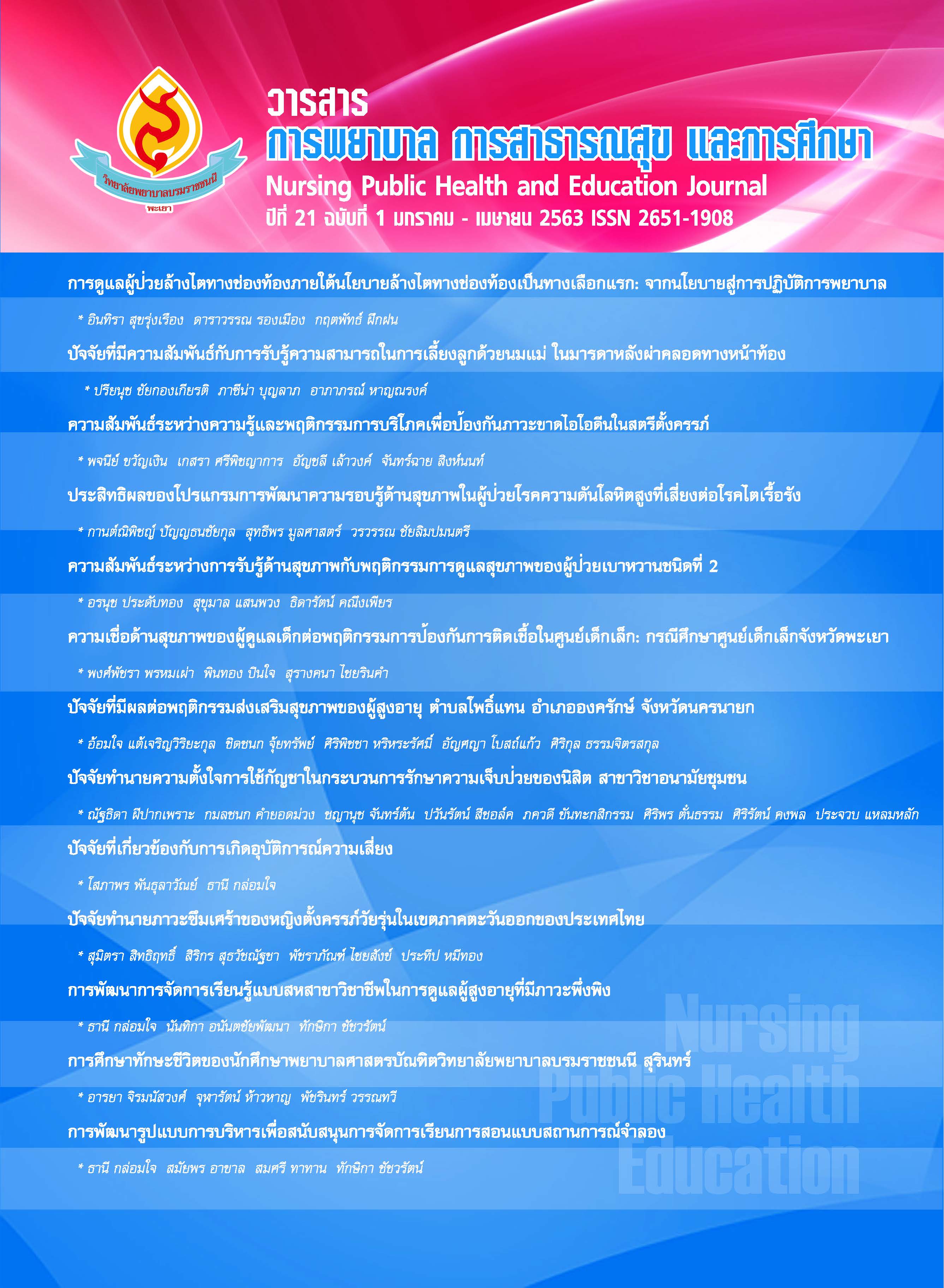การพัฒนารูปแบบการบริหารเพื่อสนับสนุนการจัดการเรียน การสอนแบบสถานการณ์จำลอง
คำสำคัญ:
การบริหารการเรียนการสอนแบบสถานการณ์จำลอง, การคิดวิเคราะห์, ความเชื่อมั่นในตนเองบทคัดย่อ
การวิจัยและพัฒนารูปแบบการบริหารเพื่อสนับสนุนการจัดการเรียนการสอนแบบสถานการณ์จำลอง มีวัตถุประสงค์เพื่อ 1) ศึกษาสภาพการณ์การบริหารเพื่อสนับสนุนการจัดการเรียนการสอนแบบสถานการณ์จำลอง 2) พัฒนารูปแบบการบริหารเพื่อการสนับสนุนการจัดการเรียนการสอนแบบสถานการณ์จำลอง และ 3) ศึกษาผลของการใช้รูปแบบการบริหารเพื่อการสนับสนุนการจัดการเรียนการสอนแบบสถานการณ์จำลอง โดยแบ่งขั้นตอนการวิจัยออกเป็น 4 ขั้นตอน คือ ขั้นตอนที่ 1 การศึกษาสภาพการณ์การบริหารเพื่อสนับสนุนการจัดการเรียนการสอนแบบสถานการณ์จำลองจากอาจารย์พยาบาล จำนวน 45 คน ด้วยแบบสอบถาม แบ่งเป็น 3 ส่วน ประกอบด้วย ข้อมูลทั่วไป การบริหารเพื่อสนับสนุนการจัดการเรียนการสอนแบบสถานการณ์จำลองและการจัดการเรียนการสอนแบบสถานการณ์จำลองตรวจสอบความเที่ยงตรงเนื้อหา โดยผู้ทรงคุณวุฒิ 5 ท่าน พบว่ามีค่า IOC เท่ากับ 0.60-1.00 และค่าความเชื่อมั่นของแบบสอบถามด้วยวิธีของ Cronbachได้ค่าความเชื่อมั่น เท่ากับ 0.89 และ 0.91 ตามลำดับ วิเคราะห์ข้อมูลด้วยสถิติความถี่ ร้อยละ ค่าเฉลี่ยและส่วนเบี่ยงเบนมาตรฐาน ขั้นตอนที่ 2 การพัฒนารูปแบบการบริหารเพื่อสนับสนุนการจัดการเรียนการสอนแบบสถานการณ์จำลอง ด้วยการระดมความคิด(Brainstorming)ของผู้ที่เกี่ยวข้อง และขั้นตอนที่ 3 ตรวจสอบรูปแบบการบริหารเพื่อสนับสนุนการจัดการเรียนการสอนแบบสถานการณ์จำลองโดยการจัดประชุมอย่างเป็นทางการ(Connoisseurship)โดยผู้ทรงคุณวุฒิ จำนวน 7 คน ขั้นตอนที่ 4การประเมินผลการใช้รูปแบบการบริหารเพื่อสนับสนุนการจัดการเรียนการสอนโดยใช้สถานการณ์จำลอง ภายหลังเสร็จสิ้นการเรียนทฤษฎีและการฝึกภาคปฏิบัติในตึกผู้ป่วย โดยอาจารย์พยาบาล จำนวน 25 คนและนักศึกษาพยาบาล จำนวน 99 คน ด้วยแบบสอบถามซึ่งประกอบด้วย 1) แบบประเมินการจัดการเรียนการสอนแบบสถานการณ์จำลอง 2) แบบประเมินความพึงพอใจ 3) แบบวัดการคิดวิเคราะห์ และ 4) แบบประเมินความเชื่อมั่นในตนเองของนักศึกษา ซึ่งผ่านการตรวจสอบความเที่ยงตรงของเนื้อหา (Content Validity) เพื่อหาค่า IOC ซึ่งมีค่าตั้งแต่ 0.60-1.00 และค่าความความเชื่อมั่นของแบบสอบถามตามวิธีของ Cronbach มีค่าความเชื่อมั่นเท่ากับ 0.91, 0.89, 0.83และ 0.86ตามลำดับ วิเคราะห์ข้อมูลโดยใช้สถิติ ค่าเฉลี่ย ส่วนเบี่ยงเบนมาตรฐานและ Independent T-test ผลการศึกษาสภาพการณ์การบริหารการจัดการเรียนการสอนแบบสถานการณ์จำลองพบว่าภาพรวมของการบริหารเพื่อสนับสนุนการจัดการเรียนการสอนแบบสถานการณ์จำลอง ของผู้บริหาร อยู่ในระดับปานกลาง ส่วนภาพรวมของการจัดการเรียนการสอนแบบสถานการณ์จำลองตามความเห็นของอาจารย์ อยู่ในระดับมาก สำหรับรูปแบบที่พัฒนา PHAYAO SIM Model มีความเหมาะสมและเป็นไปได้ในการนำไปใช้ ผลของการใช้รูปแบบ การบริหารเพื่อสนับสนุนการจัดการเรียนการสอนแบบสถานการณ์จำลอง ภายหลังสิ้นสุดการเรียนภาคทฤษฎี พบว่า ภาพรวมของการจัดการเรียนการสอนแบบสถานการณ์จำลองตามความเห็นของอาจารย์และนักศึกษามีความเห็นไปในทิศทางเดียวกัน อยู่ในระดับมาก สำหรับความคิดเห็นด้านความพึงพอใจในการจัดการเรียนการสอนแบบสถานการณ์จำลอง นักศึกษามีความเห็นอยู่ในระดับมาก ส่วนผลสัมฤทธิ์ของนักศึกษาได้แก่ การคิดวิเคราะห์และความเชื่อมั่นในตนเองของนักศึกษา จากการประเมินของอาจารย์และการประเมินตนเองของนักศึกษาอยู่ในระดับมาก และเมื่อเปรียบเทียบค่าเฉลี่ยคะแนนความคิดเห็นเกี่ยวกับการคิดวิเคราะห์ และความเชื่อมั่นในตนเองของนักศึกษา ปรากฏว่า นักศึกษาประเมินตนเองมีค่าเฉลี่ยมากกว่าการประเมินของอาจารย์อย่างมีนัยสำคัญทางสถิติที่ระดับ 0.00จากผลการศึกษาแสดงให้เห็นว่ารูปแบบPHAYAO SIM Modelที่พัฒนาขึ้นสามารถช่วยส่งเสริมการจัดการเรียนการสอนแบบสถานการณ์จำลองได้อย่างมีประสิทธิภาพ
เอกสารอ้างอิง
กิตติพร เนาว์สุวรรณ, เสริมศักดิ์ วิศาลาภรณ์ และ วิทวัส ดิษยะศริน สัตยารักษ์.(2558). กลวิธีการพัฒนาอัตลักษณ์ของนักศึกษา วิทยาลัยพยาบาล กระทรวงสาธารณสุข. วารสารหาดใหญ่วิชาการ,13(2), 117-132.
จิราภา เพียรเจริญ. (2556). บทบาทผู้บริหารในการส่งเสริมการจัดการเรียนรู้ของครู ตามหลักสูตรสถานศึกษาขั้นพื้นฐาน ในโรงเรียนมัธยมศึกษา จังหวัดปทุมธานี. (วิทยานิพนธ์ศึกษาศาสตรมหาบัณฑิตสาขาวิชาการจัดการการศึกษา) กรุงเทพฯ. มหาวิทยาลัยธุรกิจบัณฑิตย์.
ฉลอง ชาตรูประชีวิน. (2552). การพัฒนากลยุทธ์การส่งเสริมการจัดกิจกรรมเพื่อสร้างคุณธรรมที่พึงประสงค์ของนิสิตนักศึกษาในสถาบันอุดมศึกษาของรัฐ. (วิทยานิพนธ์การศึกษาดุษฎีบัณฑิต สาขาวิชาการบริหารการศึกษา) พิษณุโลก. มหาวิทยาลัยนเรศวร.
ณรงค์ กาญจนะ. (2553). เทคนิคและทักษะการสอนเบื้องต้น เล่ม 1. สงขลา: คณะครุศาสตร์ มหาวิทยาลัยราชภัฎสงขลา.
ทิศนา แขมมณี. (2557). ศาสตร์การสอนองค์ความรู้เพื่อการจัดกระบวนการเรียนรู้ที่มีประสิทธิภาพ. กรุงเทพฯ: สำนักพิมพ์แห่งจุฬาลงกรณ์มหาวิทยาลัย.
ธานี กล่อมใจ, ทักษิกา ชัชวรัตน์, และสมัยพร อาขาล.(2561). ปัจจัยที่เกี่ยวข้องกับประสิทธิผลการจัดการเรียนการสอนแบบสถานการณ์จําลองในหมวดวิชาชีพการพยาบาลของวิทยาลัยพยาบาลบรมราชชนนีพะเยา. วารสารการพยาบาล การสาธารณสุขและการศึกษา, 20(1), 3-15.
รวมพร มินานนท์, จินตนาพร สัมฤทธิ์โชค, จิราพัชร์ ปัญญาดี, อัญพัชญ์ วิวัฒน์กมลชัย, และชญาณิศา เขมทัศน์. (2556). ปัจจัยที่มีผลต่อการจัดการเรียนการสอนในกระบวนวิชาหลักการและเทคนิคการพยาบาลภาคทฤษฏีและภาคปฏิบัติวิทยาลัยพยาบาลบรมราชชนนี เชียงใหม่. พยาบาลสาร, 40(4), 126-138.
วงเดือน สุวรรณคีรี, อรพิน จุลมุสิ, ทยุตา อินทร์แก้ว, ฐิติอาภา ตั้งค้าวานิช, และ สุจินต์ เรืองรัมย์. (2560). ความพึงพอใจและความเชื่อมั่นในตนเองในการพยาบาลผู้ป่วยวิกฤตของนิสิตพยาบาลที่เรียนโดยใช้สถานการณ์จำลอง. วารสารการพยาบาลและสุขภาพ, 11(3), 167-177.
วิภาดา คุณาวิกติกุล. (2558). การเรียนการสอนสาขาพยาบาลศาสตร์ ในยุคศตวรรษที่ 21. พยาบาลสาร, 4(2), 152-156.
วิโรจน์ สารรัตนะ. (2553). ผู้บริหารโรงเรียนสามมิติ การพัฒนาวิชาชีพสู่ความเป็นผู้บริหารที่มีประสิทธิภาพ. ขอนแก่น: คลังนานาวิทยา.
สำนักงานคณะกรรมการการศึกษาขั้นพื้นฐาน. (2559). นโยบายของสำนักงานคณะกรรมการการศึกษาขั้นพื้นฐาน. ปีงบประมาณ พ.ศ. 2559. กรุงเทพ: สำนักวิชาการและมาตรฐานการศึกษา
สายสมร เฉลยกิตติ, พรนภา คำพราว, และสมพิศ พรหมเดช. (2557). ความปลอดภัยของผู้ป่วยกับคุณภาพบริการพยาบาล. วารสารพยาบาลทหารบก, 15(2), 66-70.
สุรชาติ สิทธิปกรณ์ และคณะ. (2561). ผลของการจัดการเรียนรู้ด้วยหุ่นจำลองเสมือนจริงต่อความมั่นใจในตนเองและความพึงพอใจของนิสิตพยาบาลชั้นปีที่ 3 คณะพยาบาลศาสตร์มหาวิทยาลัยมหาสารคาม.การประชุมวิชาการ “มหาวิทยาลัยมหาสารคามวิจัยครั้งที่ 14” 50 ปีมหาวิทยาลัยมหาสารคาม ‘ผู้มีปัญญาพึงเป็นอยู่เพื่อมหาชน’, 6 กันยายน 2561.
Ahn, H., & Kim, H.Y. (2015). Implementation and outcome evaluation of high-fidelity simulation scenarios to integrate cognitive and psychomotor skills for Korean nursing students. Nurse Education Today, 35(5), 706-711.
Astin, A.W. (1993). What matters in college?. San Francisco: Jossey-Bass.
Boer, H. (2009). The changing nature of the academic deanship leadership. Higher Education, 5(3), 347-364.
Cant, R. P, & Cooper, S. J. (2010). Simulation-based learning in nurse education: systematic review. Journal of Advanced Nursing, 66(1), 3-15.
Hick, F. D., Coke, L.,& Li, S. (2009). The effect of high-fidelity simulation on nursing students’ Knowledge and performance: A pilot study.Chicago, IL: National Council of State Boards of Nursing.
Khalaila, R. (2014). Simulation in Nursing Education: an Evaluation of Students’ Outcomes at Their First Clinical Practice Combined with Simulations. Nursing Education Today, 34(2), 252-258.
Luctker-Flude, M., Wilson-Keates, B., & Larocque, M. (2012). Evaluating high-fidelity human simulators and standardized patients in undergraduate nursing health assessment course. Nursing Education Today, 32(4), 448-452.
Pasquale, S. J. (2013). Education and Learning Theory. In A.I. Levine et al. (Eds.), The Comprehensive Textbook of Healthcare Simulation, (pp. 51-55). Retrieved July 6, 2019, from doi: 10.1007/978-1-4614-5993-4_3
Phrampus, P.E., & O’Donnell, J.M. (2013). Debriefing using a structured and supported approach.In A.I. Levine et al. (Eds.), The Comprehensive Textbook of Healthcare Simulation, (pp. 73-84). Retrieved July 6, 2019, from doi: 10.1007/978-1-4614-5993-4_6, ©Springer Science + Business Media New York.
Robbins, S. P., & Coulter, M. (2017). Management (14th ed.). New Jersey: Prentice Hall.
Waxman, K.T. (2010). The development of evidence-based clinical simulation scenarios : Guidelines for nurse educators. Journal of Nursing Education, 49(1), 29-35.
ดาวน์โหลด
เผยแพร่แล้ว
รูปแบบการอ้างอิง
ฉบับ
ประเภทบทความ
สัญญาอนุญาต
ลิขสิทธิ์ (c) 2020 วารสารการพยายาล การสาธารณสุข และการศึกษา

อนุญาตภายใต้เงื่อนไข Creative Commons Attribution-NonCommercial-NoDerivatives 4.0 International License.



